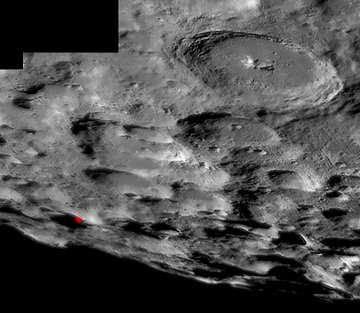As Steve posted the other day, NASA’s LCROSS satellite will impact near the Moon’s south pole on Friday morning in an attempt to detect ice.
Based on strong circumstantial evidence from earlier missions, scientists believe that some of the Moon’s craters at the poles, which are permanently in shadow, may harbour ice from ancient comet impacts. Being in shadow, they never receive light/heat from the sun which would cause the ice to sublimate. This could be very significant as we head back to the Moon, hopefully on a permanent basis since water is heavy to transport and essential for life. Plus it can be used to create oxygen and rocket fuel.

The impactors, actually consist of 2 parts. The spent Centaur rocket booster which sent the main probe to the moon, will hit first before the main satellite meets the same fate. This booster, with a mass of 2200kg, is expected to raise a plume of water ice and dust up to 10 kilometres high, clearing the shadow of the crater and once exposed to sunlight, will be visible from Earth. Earth based telescopes, mostly in western North America and the Pacific will be trained to capture this event.
Four minutes later the main sensing probe will enter the plume and examine the contents for any elements, and then plunge into the surface. With a mass of about 700kg, it won’t raise as much of a plume, but it’s still expected to provide useful science.
What’s interesting about this event is that amateur astronomers have a chance to observe this event. It is expected to be visible in scopes of at least 10 inches and we have several that meet this requirement in our club. Unfortunately the impact is going to take place at 7:30am local time and it will be bright (assuming we’re not covered with clouds). This will make picking out the flash very difficult. Possibly with enough aperture, the right filtering and recording exposures, plus some post-processing, it may be possible to capture this event from our area. (I know, sounds like a long shot doesn’t it?)
There are lots of resources to find out more about this event. Here’s a good one to get started with lots of info, including a lunar image showing the impact location.
Regrettably the weather is not looking too promising for our area in the morning (considering this year, it shouldn’t be a surprise). So if we can’t observe through our own scopes, the next best option will be NASA TV (online and cable). NASA has coverage of the event starting at 6:30am (local) and will be providing live images from the Moon and Earth.
Good luck and enjoy however you end up experiencing this fascinating event.
